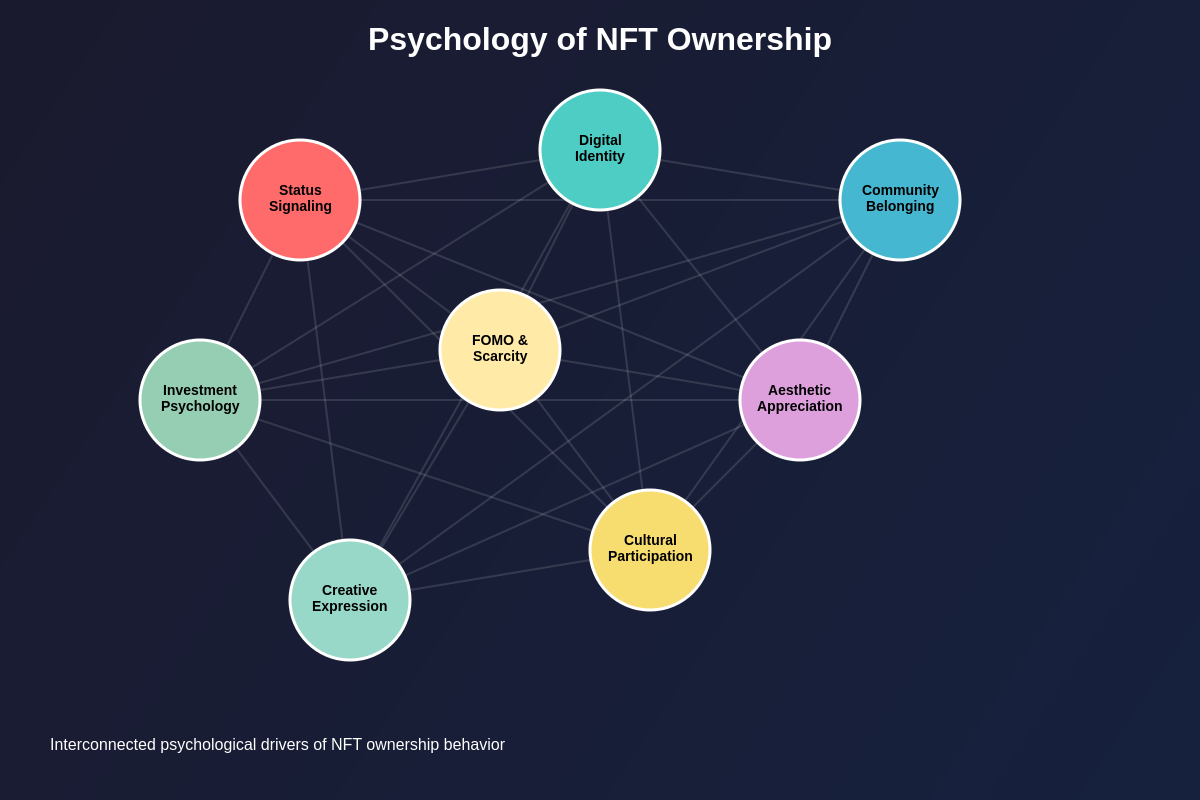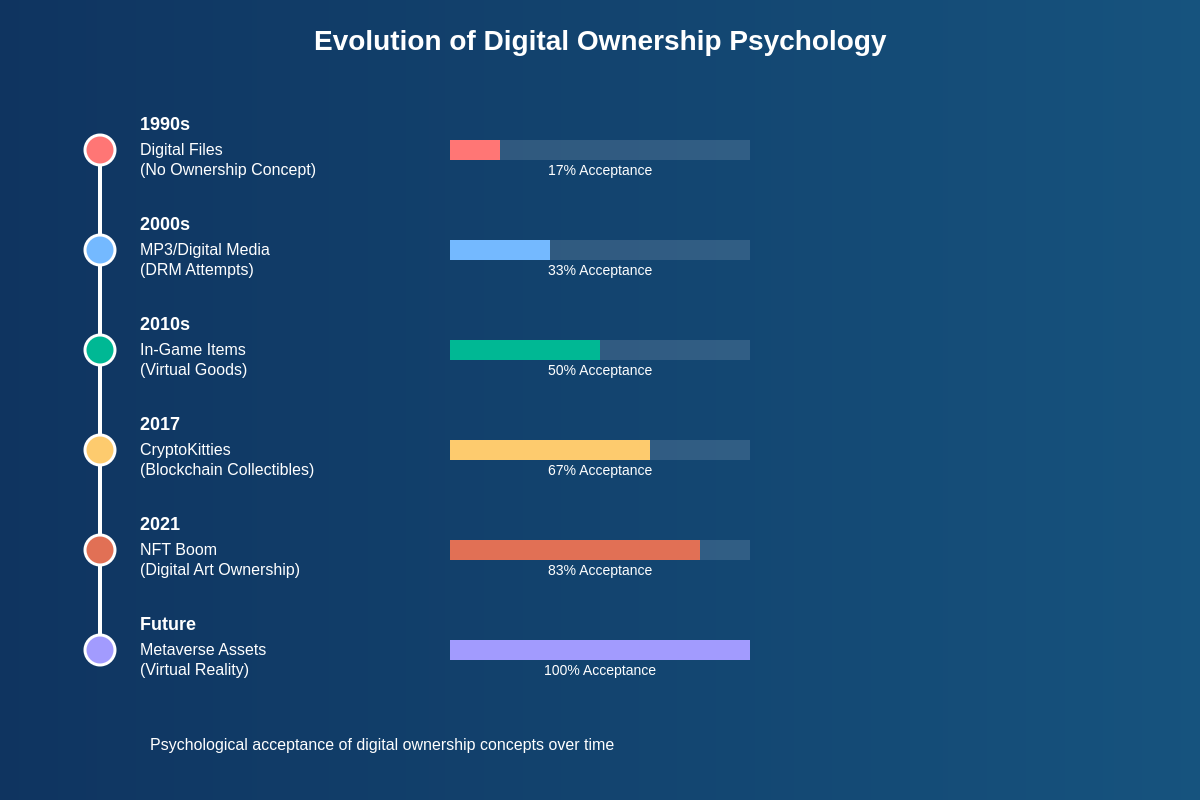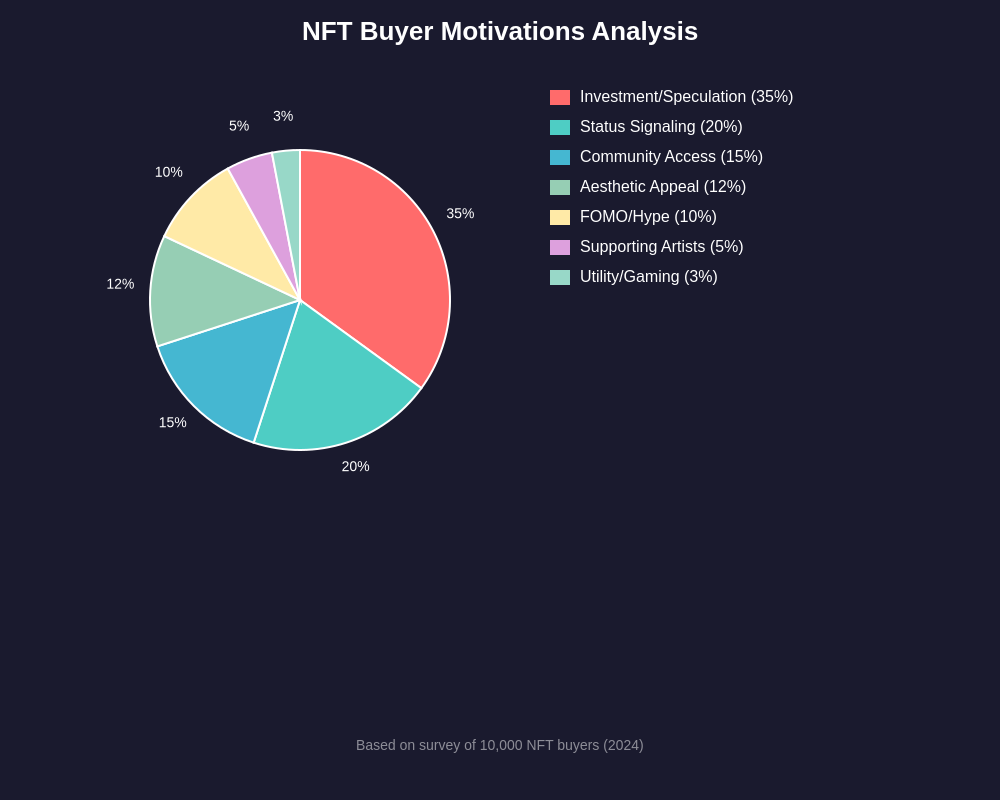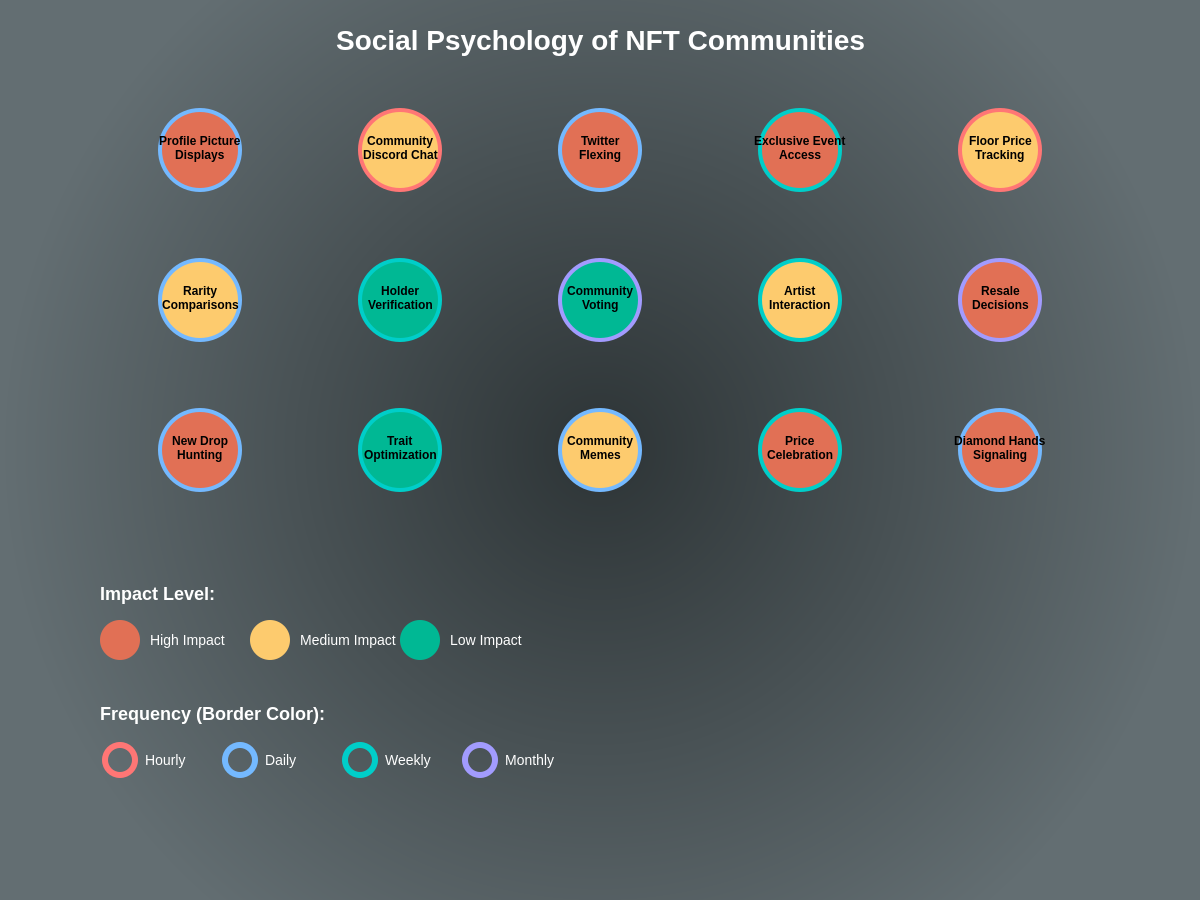The phenomenon of Non-Fungible Tokens (NFTs) has revolutionized the digital art market and challenged traditional notions of ownership, value, and collecting behavior in ways that extend far beyond simple monetary transactions. Understanding why people purchase digital art in the form of NFTs requires a deep dive into the psychological motivations that drive human behavior in digital spaces, the social dynamics of online communities, and the complex interplay between technology, identity, and status signaling that characterizes modern digital culture.
Explore TradingView’s comprehensive NFT market data to understand the psychological cycles that drive digital art valuations across different market conditions and investor sentiment patterns.
The Digital Ownership Paradox
The concept of owning digital art through NFTs presents a fascinating psychological paradox that challenges conventional understanding of ownership and possession in the digital age. Unlike physical artwork that can be touched, displayed in one’s home, and physically possessed, NFT ownership represents a more abstract form of possession that exists primarily as blockchain-verified proof of authenticity and ownership rights. This digital ownership paradigm triggers unique psychological responses that differ significantly from traditional collecting behaviors and require new frameworks for understanding human motivation in virtual environments.

The psychological appeal of digital ownership stems partly from humanity’s deep-seated need to collect, categorize, and possess items of perceived value, a behavior pattern that has evolved over millennia and now manifests in digital spaces through NFT collecting. The blockchain technology underlying NFTs provides a technological solution to the historical problem of digital scarcity, creating artificial scarcity in an environment where perfect copies are otherwise trivial to create, thus satisfying the psychological requirement for exclusivity that drives many collecting behaviors.
The verification aspect of NFT ownership appeals to the human desire for authenticity and provenance, providing digital collectors with the same psychological satisfaction that comes from owning an authenticated piece of traditional art. The immutable record of ownership and transaction history stored on blockchain networks creates a digital equivalent to the provenance documentation that accompanies valuable physical artworks, satisfying collectors’ needs for legitimacy and historical context.
Social Identity and Status Signaling
NFT ownership serves as a powerful form of social identity expression and status signaling within digital communities, particularly on social media platforms where profile pictures and digital displays have become primary means of self-presentation. The practice of using expensive NFTs as profile pictures on platforms like Twitter represents a form of conspicuous consumption that parallels traditional luxury goods, allowing individuals to signal their financial success, technological sophistication, and alignment with contemporary digital culture trends.

The social aspect of NFT ownership extends beyond individual status signaling to include membership in exclusive communities and access to special events, services, or content that are gated by NFT ownership. This community membership component appeals to fundamental human needs for belonging and social connection, creating psychological value that transcends the purely aesthetic or investment-oriented aspects of digital art ownership. The shared identity formed around specific NFT collections creates strong in-group dynamics that reinforce ownership decisions and create social pressure to maintain membership through continued holding.
The phenomenon of “diamond hands” in NFT communities reflects the psychological commitment that develops when social identity becomes intertwined with digital asset ownership, making the decision to sell more emotionally complex than simple profit-maximization would suggest. The social cost of selling prestigious NFTs includes potential loss of community status, social connections, and identity markers that have become integrated into one’s online persona and social relationships.
Platform-specific features like verified profiles, exclusive access to creator content, and community governance rights create additional layers of social utility that justify NFT ownership beyond mere speculation or aesthetic appreciation. These features tap into human desires for influence, recognition, and participation in exclusive groups, providing psychological rewards that traditional digital art ownership cannot replicate.
Investment Psychology and Speculative Behavior
The investment aspect of NFT ownership introduces complex psychological dynamics related to risk tolerance, loss aversion, speculation, and the gamification of art collecting that fundamentally alter the relationship between collector and artwork. Unlike traditional art collecting, where aesthetic appreciation often precedes investment considerations, NFT markets have created environments where speculative psychology dominates purchasing decisions and influences how buyers perceive and value digital artworks.

The psychological appeal of potential massive returns on NFT investments triggers reward-seeking behaviors similar to those observed in gambling and other high-risk, high-reward activities. The documented cases of NFTs selling for millions of dollars create powerful psychological anchors that influence buyer expectations and justify high-risk purchases based on outlier outcomes rather than typical market performance. This lottery-like psychology helps explain why individuals make seemingly irrational investments in digital art based on slim chances of extraordinary returns.
Monitor real-time NFT market psychology through TradingView’s sentiment indicators to understand how fear, greed, and FOMO cycles drive digital art valuations and collector behavior patterns across different market conditions.
Loss aversion psychology plays a significant role in NFT holding behavior, with owners often reluctant to sell at losses even when fundamental factors suggest price declines are likely to continue. The public nature of blockchain transactions creates additional psychological pressure to avoid realizing losses, as sell transactions are permanently recorded and visible to community members who may interpret sales as lack of conviction or financial distress.
The gamification elements present in many NFT projects, including rarity rankings, trait combinations, and breeding mechanisms, appeal to achievement-oriented psychology and create engagement patterns similar to video games and collectible card games. These game-like elements provide psychological rewards through discovery, completion, and optimization activities that extend far beyond simple ownership satisfaction.
Cultural and Technological Identity Expression
NFT ownership serves as a powerful mechanism for expressing cultural identity and technological affinity, allowing individuals to signal their participation in cutting-edge digital culture and their understanding of emerging technological paradigms. The decision to purchase NFTs often reflects deeper psychological needs to identify with innovative communities, demonstrate technological sophistication, and participate in cultural movements that are perceived as defining the future of art, technology, and digital interaction.
The early adopter psychology that drives many NFT purchases stems from the desire to be associated with technological innovation and cultural transformation, providing psychological satisfaction similar to that experienced by early adopters of other transformative technologies. This pioneer identity appeals to individuals who derive self-worth from being ahead of mainstream adoption curves and who value being recognized as forward-thinking and technologically savvy.
The intersection of art, technology, and finance that characterizes the NFT space appeals to individuals whose identity spans multiple domains, creating psychological satisfaction through participation in a movement that integrates traditionally separate fields. This interdisciplinary appeal attracts collectors who identify as both art enthusiasts and technology innovators, providing a unique cultural space that satisfies multiple aspects of their identity simultaneously.
The decentralized and anti-establishment ethos associated with blockchain technology appeals to individuals whose political and social identities align with concepts of decentralization, individual sovereignty, and resistance to traditional institutional control. NFT ownership becomes a form of political expression that supports alternative economic and social systems while providing tangible participation in the construction of new digital economies.
Aesthetic Appreciation and Digital Native Culture
While speculative and social factors dominate public discourse around NFT ownership, genuine aesthetic appreciation for digital art forms a crucial psychological foundation for sustainable collecting behavior and long-term market development. Digital native generations who have grown up immersed in digital media and interactive entertainment possess different aesthetic sensibilities and appreciation frameworks than previous generations, making digital art ownership psychologically satisfying in ways that older demographics may not fully understand.
The native digital aesthetics found in many successful NFT collections, including pixelated art, generative designs, and interactive elements, resonate with individuals whose visual preferences have been shaped by video games, digital interfaces, and computer-mediated communication. This aesthetic alignment creates genuine emotional connections to digital artworks that transcend speculative considerations and provide lasting psychological satisfaction through ownership and display.
The programmable and interactive nature of some NFTs appeals to collectors who appreciate the technological artistry involved in creating dynamic, evolving, or responsive digital artworks. This appreciation for computational creativity represents a new form of aesthetic experience that traditional art markets cannot provide, creating unique psychological rewards for collectors who understand and value the technical innovation underlying digital art creation.
The global accessibility and platform-agnostic nature of digital art ownership appeals to collectors who value the democratizing aspects of NFT markets and who appreciate being able to support artists directly without traditional gallery intermediaries. This direct creator-collector relationship creates psychological satisfaction through perceived impact on artist success and participation in alternative economic models that align with collectors’ values regarding artist compensation and market accessibility.
Psychological Ownership and Digital Attachment
The development of psychological ownership toward digital assets represents a fascinating evolution in human attachment behavior that extends traditional ownership psychology into virtual environments where physical possession is impossible. Research in environmental psychology and consumer behavior demonstrates that psychological ownership can develop independently of legal ownership, creating strong emotional connections to objects, places, or experiences that individuals feel belong to them even without formal possession rights.
NFT ownership triggers psychological ownership through several mechanisms including investment of time, attention, and resources into acquiring and maintaining digital assets, customization and personalization opportunities provided by some NFT projects, and the exclusive access and control rights that accompany blockchain-verified ownership. These mechanisms create emotional attachment and territorial feelings toward digital assets that mirror traditional ownership psychology despite the intangible nature of the underlying assets.
The ritual aspects of NFT acquisition, including research, bidding, transaction completion, and community celebration, create psychological investment that strengthens ownership feelings and emotional attachment to digital assets. These rituals serve similar psychological functions to traditional collecting behaviors while adapting to the unique characteristics of blockchain-based transactions and digital asset management.
The personalization opportunities provided by customizable NFTs, breeding mechanisms, and evolution features allow collectors to shape their digital assets in ways that increase psychological ownership and emotional attachment. This active participation in asset development creates stronger psychological bonds than passive ownership and provides ongoing engagement opportunities that maintain interest and attachment over time.
Community Psychology and Tribal Behavior
The tribal dynamics that emerge around successful NFT collections tap into fundamental human needs for group membership, shared identity, and collective action that have evolutionary roots in human social organization. The formation of distinct communities around specific NFT projects creates powerful psychological bonds between collectors who share ownership of similar assets and who identify with the cultural values, aesthetic preferences, and social goals associated with their chosen collections.

The exclusive nature of NFT ownership creates in-group dynamics that strengthen community bonds while creating psychological barriers between holders and non-holders that reinforce the perceived value and desirability of community membership. These dynamics create powerful psychological incentives to acquire and hold NFTs as symbols of group membership while creating social pressure against selling that extends beyond simple financial considerations.
Track community sentiment and tribal dynamics through TradingView’s social sentiment tools to understand how group psychology influences NFT pricing cycles and collector behavior patterns across different digital art communities.
The shared narrative construction that occurs within NFT communities creates collective meaning and purpose that transcends individual ownership benefits, appealing to human needs for participation in larger stories and cultural movements. Community members collaborate in creating mythology, lore, and future visions for their collections that provide psychological satisfaction through creative participation and shared storytelling.
The governance and decision-making opportunities provided by some NFT projects appeal to human desires for agency and influence within communities, creating psychological ownership of collective outcomes and shared responsibility for project success. This participatory governance model creates deeper engagement and stronger community bonds than passive ownership models while providing psychological rewards through meaningful participation in group decisions.
Fear of Missing Out and Scarcity Psychology
The Fear of Missing Out (FOMO) phenomenon plays a crucial role in NFT purchasing psychology, creating urgency and impulse buying behaviors that override rational decision-making processes and lead to purchases that buyers might not make under different psychological conditions. The time-limited nature of many NFT drops, combined with artificial scarcity created by limited edition releases, triggers evolutionary psychological responses to resource scarcity that can override careful consideration of value propositions and long-term collecting goals.
The social media amplification of NFT success stories creates powerful FOMO triggers through constant exposure to stories of massive profits, exclusive access, and community membership that non-owners are missing. This continuous exposure to missed opportunities creates psychological pressure to participate in NFT markets to avoid further exclusion from potentially lucrative or socially valuable opportunities.
The scarcity psychology underlying NFT markets appeals to collectors’ desires for exclusive ownership and rare item acquisition, triggering competitive behaviors and bidding wars that can lead to prices that exceed rational valuation models. The visible scarcity created by blockchain technology and limited edition releases satisfies psychological needs for rare item ownership while creating competitive dynamics that drive price appreciation and market engagement.
The documented cases of rapid price appreciation in successful NFT collections create anchoring effects that influence buyer psychology and justify high-risk purchases based on potential future scarcity value rather than current utility or aesthetic appreciation. These psychological anchors can persist even during market downturns, influencing holding behavior and future purchase decisions.
Digital Status Goods and Luxury Psychology
NFT ownership patterns often mirror traditional luxury goods consumption psychology, with expensive digital assets serving similar psychological functions to physical luxury items including status signaling, identity expression, and exclusivity benefits. The transition of luxury consumption psychology into digital spaces represents a significant evolution in how status is constructed and displayed in online environments where traditional physical markers may be less effective or relevant.
The conspicuous consumption aspect of NFT ownership provides psychological satisfaction through public display of wealth and sophisticated taste, similar to traditional luxury goods but adapted to digital environments where profile pictures and social media presence replace physical display opportunities. This digital conspicuous consumption creates new forms of status competition and social hierarchy that appeal to individuals whose primary social interactions occur in online spaces.
The brand association benefits that come with owning NFTs from prestigious collections provide psychological value through identification with successful brands, artists, and cultural movements that enhance the owner’s perceived status and sophistication. These brand associations can provide long-term psychological value even when financial returns disappoint, creating sustained satisfaction through continued association with respected names and cultural artifacts.
The exclusivity benefits provided by high-value NFT ownership, including access to exclusive events, communities, and experiences, create psychological value that extends beyond the digital asset itself to encompass real-world benefits and social opportunities. This utility aspect of luxury NFT ownership provides tangible psychological rewards that justify high purchase prices through exclusive access rather than purely speculative considerations.
Creative Expression and Digital Identity
The role of NFTs in facilitating creative expression and digital identity construction provides psychological satisfaction for both creators and collectors who participate in the development and curation of digital art ecosystems. For collectors, the curation aspect of building NFT collections allows for creative expression through selection, combination, and display of digital assets that reflect personal aesthetic preferences and cultural identity.
The customization and modification opportunities provided by some NFT projects allow collectors to participate in the creative process and develop unique variations of base artworks that reflect their personal preferences and creative vision. This creative participation provides psychological satisfaction through artistic expression while creating stronger emotional connections to owned assets through personal investment in their development.
The social display opportunities provided by NFT ownership allow collectors to construct and present digital identities that reflect their aesthetic sophistication, cultural alignment, and personal brand in ways that traditional profile pictures and social media content cannot achieve. This identity construction function provides ongoing psychological value through self-expression and social presentation opportunities.
The supporting artist relationship that develops through direct NFT purchases provides psychological satisfaction through perceived impact on creator success and participation in artist development that traditional art markets may not facilitate as directly. This creator support aspect appeals to collectors who value their role in enabling artistic creation and who derive satisfaction from contributing to artist success stories.
Market Psychology and Behavioral Economics
The behavioral economics of NFT markets reveal complex psychological patterns that influence purchasing decisions and create market dynamics that often diverge from rational valuation models based purely on aesthetic or utility considerations. Understanding these psychological market forces provides insight into why NFT prices can exhibit extreme volatility and why market participants continue to engage despite high risks and uncertain outcomes.
The endowment effect plays a significant role in NFT holding behavior, with owners typically valuing their digital assets more highly than they would if they were considering purchasing the same assets from others. This psychological bias creates resistance to selling and contributes to price support during market downturns while creating unrealistic price expectations that can lead to missed selling opportunities during market peaks.
The availability heuristic influences NFT purchasing decisions through disproportionate attention to highly publicized success stories and extreme outcomes that may not represent typical market performance but that create powerful psychological impressions about potential returns and market opportunities. This cognitive bias can lead to overestimation of success probabilities and underestimation of risk factors that affect most NFT investments.
Analyze market psychology patterns through TradingView’s behavioral analysis tools to understand how cognitive biases and emotional cycles drive NFT market dynamics and collector decision-making processes.
The anchoring bias affects NFT valuation through initial price impressions that influence subsequent valuation judgments even when market conditions change significantly. High initial mint prices or peak sale prices create psychological anchors that can influence both buyer and seller expectations long after market conditions have shifted, creating persistent pricing inefficiencies and transaction resistance.
The confirmation bias leads NFT owners to seek information that confirms their investment decisions while avoiding or discounting information that suggests their assets may be overvalued or risky. This selective information processing can reinforce holding behavior and prevent objective reassessment of investment positions based on changing market conditions and project fundamentals.
Future Implications and Evolving Psychology
The psychological patterns underlying current NFT ownership behavior provide insights into how digital ownership and virtual asset markets may evolve as technology develops and cultural norms adapt to increased digital integration in daily life. Understanding these psychological foundations helps predict how NFT markets may mature and how ownership psychology may change as digital assets become more mainstream and utility-focused.
The normalization of digital ownership through NFT adoption may reduce the speculative psychology that currently dominates many purchasing decisions, leading to more sustainable collecting behaviors based on aesthetic appreciation, utility value, and community participation rather than pure investment speculation. This evolution toward utility-focused ownership could create more stable market conditions and longer-term collector engagement.
The development of enhanced virtual and augmented reality environments may strengthen psychological ownership of digital assets by providing more immersive display and interaction opportunities that bridge the gap between digital and physical ownership experiences. These technological developments could reduce the psychological barriers that prevent some individuals from forming strong attachments to purely digital assets.
The integration of NFTs with gaming, social media, and virtual world platforms may create new psychological motivations for digital asset ownership based on functional utility and social interaction rather than purely speculative or status-signaling considerations. This functional evolution could broaden the appeal of NFT ownership beyond current early adopter demographics and create more diverse psychological motivations for participation.
The potential development of fractional ownership, lending, and other financial innovations around NFTs may change ownership psychology by reducing barriers to entry while creating new forms of partial ownership and shared control that appeal to different psychological profiles and risk tolerances than current whole-asset ownership models.
Educational and Cultural Impact
The educational aspects of NFT ownership provide psychological satisfaction through learning about blockchain technology, digital art creation, market dynamics, and cultural trends that appeal to individuals who derive satisfaction from understanding complex systems and participating in cutting-edge developments. This educational component creates lasting value that persists beyond potential financial gains or losses from specific NFT investments.
The cultural documentation aspect of NFT collecting appeals to individuals who see themselves as participating in the preservation and curation of digital culture and art history that may become increasingly important as society becomes more digitally integrated. This historical preservation motivation provides psychological satisfaction through perceived contribution to cultural legacy and artistic documentation.
The cross-cultural exchange facilitated by global NFT markets provides psychological satisfaction through exposure to diverse artistic traditions, cultural perspectives, and creative approaches that may not be accessible through traditional local art markets. This cultural expansion aspect appeals to collectors who value diversity and global artistic expression.
The democratization of art collecting enabled by NFT markets appeals to individuals who may have been excluded from traditional art markets due to geographic, economic, or social barriers but who can now participate in art collecting and cultural curation through digital platforms. This accessibility aspect provides psychological satisfaction through participation in previously exclusive activities and cultural spaces.
The psychology of NFT ownership represents a complex intersection of traditional collecting behaviors, digital culture, speculative investment psychology, and evolving concepts of value and ownership in virtual environments. Understanding these psychological motivations provides crucial insights into why people purchase digital art and how these markets may evolve as technology and culture continue to develop. The success of NFT markets demonstrates humanity’s ability to adapt traditional psychological needs and behaviors to new technological contexts while creating entirely new forms of value, community, and identity expression that reflect the increasing integration of digital and physical experience in contemporary life.
Explore comprehensive NFT market analysis and psychological indicators through TradingView’s advanced charting tools to understand how collector psychology drives market cycles and valuation patterns across different digital art categories and community types.
Disclaimer: This article is for educational and informational purposes only and should not be construed as financial advice. NFT investments carry significant risks including total loss of investment, market volatility, and technological uncertainties. The psychological factors discussed in this article are based on general behavioral patterns and may not apply to all individuals or market conditions. Past performance of NFT investments does not guarantee future results. Always conduct thorough research and consider consulting with qualified financial advisors before making investment decisions. The author and publisher are not responsible for any financial losses that may result from acting upon information contained in this article.